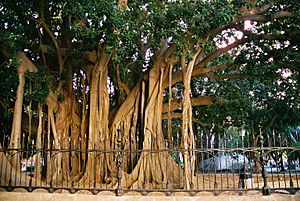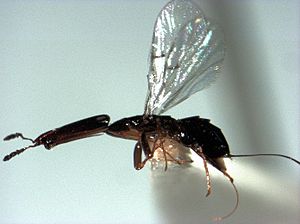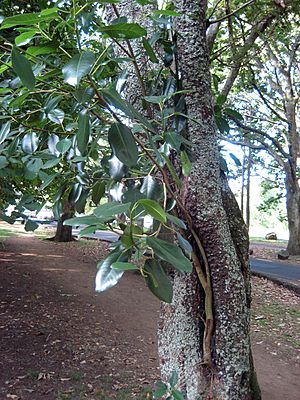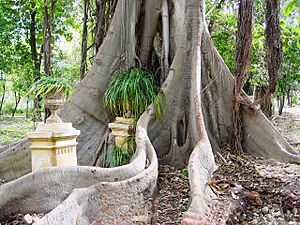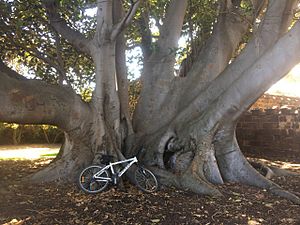Moreton Bay fig facts for kids
Quick facts for kids Moreton Bay fig |
|
|---|---|
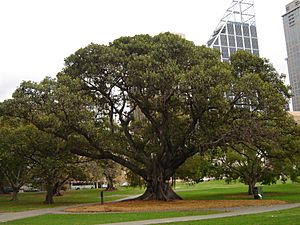 |
|
| A Moreton Bay fig tree in Sydney, planted in 1850 | |
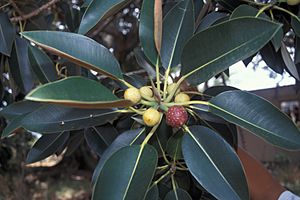 |
|
| Fruit and leaves, photographed in Hawaii | |
| Scientific classification | |
| Genus: |
Ficus
|
| Species: |
macrophylla
|
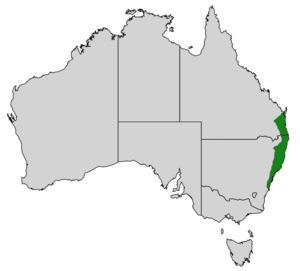 |
|
| Where the Moreton Bay fig naturally grows in Eastern Australia (in green) | |
| Synonyms | |
|
Ficus huegelii Kunth & C.D.Bouche, 1846 |
|
The Moreton Bay fig, also known as the Australian banyan, is a very large evergreen tree. It belongs to the fig family, Moraceae. This tree naturally grows in eastern Australia, from the Wide Bay–Burnett area in the north down to Illawarra in New South Wales. You can also find it on Lord Howe Island. Its common name comes from Moreton Bay in Queensland, Australia. It is famous for its huge, strong roots that look like walls.
The Moreton Bay fig is often called a strangler fig. This is because its seeds usually start growing high up in another tree. The young fig plant lives there as an epiphyte (a plant that grows on another plant but doesn't get food from it). Its roots then grow downwards until they reach the ground. Once the roots are in the soil, the fig tree grows much bigger and stronger. It can eventually "strangle" and kill the host tree, becoming a standalone tree itself. These trees can grow up to 60 meters (200 feet) tall! Their large, tough, dark green leaves are about 15 to 30 centimeters (6 to 12 inches) long.
The fruit of the Moreton Bay fig is small, round, and green. It ripens and turns purple at any time of the year. This fruit is special; it's called a syconium, which means the flowers are actually inside the fruit. Like all fig trees, the Moreton Bay fig has a special partnership with tiny fig wasps. Fig trees can only be pollinated by fig wasps, and fig wasps can only reproduce inside fig flowers. Many birds, like pigeons, parrots, and other small birds, love to eat the fruit.
Moreton Bay figs are often planted in public parks and gardens in warm places. You can see them in California, Portugal, Italy, Malta, northern New Zealand, and Australia. Very old trees can become enormous. Their strong root systems mean they are only suitable for very large gardens, not small ones.
Contents
What's in a Name? (Taxonomy)
The Moreton Bay fig was first officially described in 1807 by a botanist named Christiaan Hendrik Persoon. Its scientific name, Ficus macrophylla, comes from Ancient Greek words. "Makros" means "large," and "phyllon" means "leaf." This name refers to the tree's big leaves.
For a long time, there was another name used in Europe, Ficus magnolioides. This was for a form of the tree that grew very large with a banyan shape. It was thought to be different because of its bigger, greener leaves. However, scientists later found that these differences were not enough to make it a separate species.
There's also a special form of the Moreton Bay fig found only on Lord Howe Island. This form, called Ficus macrophylla f. columnaris, often grows many column-like roots from its branches. These roots reach the ground and become extra trunks, helping to support the tree's huge crown. The form found on mainland Australia, Ficus macrophylla f. macrophylla, usually grows as a single, strong tree.
The common name, Moreton Bay fig, comes from Moreton Bay in southern Queensland, Australia, even though the tree grows in many other places too. Sometimes, it's also called the "black fig" because its old bark is dark.
How to Spot a Moreton Bay Fig (Description)
The Moreton Bay fig is an evergreen tree, meaning it keeps its leaves all year round. It can grow up to 60 meters (200 feet) tall. The main trunk can be very wide, up to 2.4 meters (8 feet) across, with thick, noticeable buttress roots. These roots look like large, flat walls at the base of the trunk. The bark is rough, grey-brown, and has different marks on it. The Lord Howe Island form of this fig tree is special because it drops aerial roots from its branches. These roots grow down to the ground and then get thicker, turning into extra trunks that help hold up the tree's wide top.
This tree is a rainforest plant. In the rainforest, it often starts as an epiphyte (a plant growing on another tree) and becomes a strangler vine. When its seeds land on a host tree, it sends its "strangler" roots down the host's trunk. Eventually, these roots surround and kill the host tree, leaving the fig tree standing alone.
Each Moreton Bay fig tree has both male and female flowers. As its name suggests, it has large, oval-shaped, tough, dark green leaves. They are about 15 to 30 centimeters (6 to 12 inches) long and grow one after another along the stems. If you cut or break a leaf or branch, a milky sap will come out. The figs themselves are about 2 to 2.5 centimeters (0.8 to 1 inch) wide. They change from green to purple with lighter spots as they ripen. You can find ripe fruit all year, but there are more from February to May.
Where Moreton Bay Figs Grow (Distribution and Habitat)
The Moreton Bay fig is native to the eastern coast of Australia. It grows from the Wide Bay–Burnett region in central Queensland down to the Shoalhaven River in New South Wales. You can find it in subtropical, warm temperate, and dry rainforests. Here, it often grows as an emergent tree, meaning its top can be seen towering above the rest of the forest canopy. It especially likes to grow along rivers on rich, alluvial soils (soils made from river deposits). In the Sydney area, these figs grow from sea level up to 300 meters (1,000 feet) high. They thrive in places that get about 1,200 to 1,800 millimeters (47 to 71 inches) of rain each year.
These trees often grow alongside other rainforest trees. As rainforests were cleared for farming, some Moreton Bay figs were left standing in fields. Farmers valued them for the shade and shelter they provided for livestock. One such tree even gave its name to the suburb of Figtree in New South Wales.
Who Lives with the Fig? (Ecology)
The Moreton Bay fig produces a huge amount of fruit, making it a very important food source in the rainforest. Many birds eat its fruit, including the green catbird, wompoo fruit-dove, topknot pigeon, and rose-crowned fruit-dove. Other birds like the yellow-eyed cuckoo-shrike, pied currawong, Australasian figbird, regent bowerbird, satin bowerbird, and Lewin's honeyeater also enjoy the figs. Large fruit bats, such as the grey-headed flying-fox, also feed on the fruit.
Besides the special fig wasp that pollinates the tree, other tiny wasps also live inside the fig fruits. These wasps don't help with pollination. There are also tiny worms called nematodes that live in the figs and can be parasites to the pollinating wasps.
Small insects called thrips sometimes feed on the new leaves of the Moreton Bay fig. When they feed, the leaves can become twisted and curled. Other insects, like psyllids, can also attack stressed trees, causing them to lose their leaves. Caterpillars of a moth species can also strip the leaves from the trees. The tree can also be a host for a type of longhorn beetle. Sometimes, a fungus called brown root rot can infect and kill these trees.
Reproduction and Life Cycle
Fig trees and fig wasps have a very special relationship called mutualism. This means they both depend on each other to survive. Fig trees can only be pollinated by fig wasps, and fig wasps can only reproduce inside fig flowers. Usually, each type of fig tree needs one specific type of wasp for pollination. For the Moreton Bay fig, this special wasp is called Pleistodontes froggatti.
The fig fruit is actually an upside-down flower cluster called a syconium. Inside, there are tiny flowers. The Moreton Bay fig tree has both male and female flowers on the same plant, and even in the same fruit, but they mature at different times. Female wasps enter the fig fruit and lay their eggs in the female flowers when they are ready. Later, these eggs hatch, and the young wasps mate. The new female wasps then collect pollen from the male flowers, which have now matured. They then leave the fig to visit other fig fruits and repeat the process, spreading pollen as they go.
Studies have shown that Moreton Bay fig trees often have both male and female fruits at the same time. This can be helpful for reproduction, especially for trees in small, isolated groups, like those on islands. The Moreton Bay fig can also handle cooler weather better than some other fig species. These trees can live for over 100 years in the wild!
When Figs Become Invaders
The Moreton Bay fig is often planted in Hawaii and northern New Zealand. In both places, it has now started to grow wild, meaning it has become "naturalized." This happened because its pollinating wasp, Pleistodontes froggatti, arrived there. In Hawaii, the wasp was brought on purpose in 1921. In New Zealand, it was first seen in 1993, likely having traveled a long distance from Australia.
When the wasp arrived, the fig trees started producing many fruits with tiny seeds. Birds then spread these seeds. In New Zealand and Hawaii, Moreton Bay figs have been found growing on both native and introduced trees. Because these figs grow so large and strong in New Zealand, and because animals like possums don't eat them, there's a concern that they might take over forests and other native plant areas. Sometimes, these trees also escape from gardens in places like Turkey.
How People Use Moreton Bay Figs (Uses)
The Moreton Bay fig has been widely planted in public parks in areas that don't get frost. Early settlers in Australia liked to plant them. Around the early 1900s, Joseph Maiden, who directed the Royal Botanic Gardens in Sydney, suggested planting these trees in uniform rows along streets. He recommended spacing them about 30 meters (100 feet) apart. This was far enough so they wouldn't crowd each other as they grew, but close enough so their branches would eventually connect.
These trees can grow to be enormous, even in drier climates. Impressive examples can be seen in places like Deniliquin and Hay in Australia. They can handle light frosts and salty air near the coast. Their fruit is also good for city wildlife. However, their huge size means they are only suitable for the largest gardens. Their roots are very strong and can damage pipes, sidewalks, and roads. Also, the large amounts of crushed fruit can make a mess on the ground. The figs themselves are edible but don't taste very good and are quite dry.
Because of their strong, buttressed roots, Moreton Bay figs are often used for bonsai (the art of growing miniature trees). However, they are better suited for larger bonsai styles because their leaves don't shrink much in size, and their stems have long spaces between leaves. They can also be grown as indoor plants in places with medium to bright light. The tree's soft, light wood has a wavy texture and is used for making cases. Aboriginal people traditionally used the tree's fibers to make fishing nets.
Famous Moreton Bay Fig Trees
You can find large Moreton Bay fig trees in many parks and properties across eastern and northeastern Australia. The botanical gardens in Brisbane, Melbourne, and Sydney have many specimens that were planted in the mid-1800s. These trees can be up to 35 meters (115 feet) tall. Near Wollongong, there's a Moreton Bay fig that measures 58 meters (190 feet) tall. A famous 150-year-old tree in Sydney, called the "Tree of Knowledge," was sadly cut down in 2016 for a new light rail project.
New Zealand also has many large Moreton Bay fig trees. One tree in Pahi, Northland, was measured in 1984 as 26.5 meters (87 feet) high and 48.5 meters (159 feet) wide. By 2011, its trunk had a girth of 14.8 meters (48.5 feet)!
The Moreton Bay fig was brought to California in the United States in the 1870s. In 1980, 13 of these trees were named "Exceptional Trees of Los Angeles." The tallest Moreton Bay fig in North America is next to San Diego's Natural History Museum. It was planted in 1914 and by 1996, it was 23.7 meters (78 feet) high and 37.4 meters (123 feet) wide. The widest Moreton Bay fig in North America is in Santa Barbara, California. It was planted in 1876 by a young girl who got a seedling from an Australian sailor. This tree measures an amazing 175 feet (53 meters) across! The Aoyama Tree in downtown Los Angeles was planted by Japanese Americans in the early 1900s.
In South Africa, two specimens have the widest canopies of any single-trunk trees in the country. One is in the Arderne Gardens in Claremont, and the other is at the Pretoria Zoo. The Pretoria tree was planted before 1899. By 2012, it was 27 meters (89 feet) tall with a canopy width of 43.1 meters (141 feet). There's also a notable tree sprawling over steps at the Botanical Garden of the University of Coimbra in Portugal. Moreton Bay figs are also used in public spaces in Palermo, Sicily, with impressive trees in various gardens and squares.
Images for kids
See also
 In Spanish: Higuera de Bahía Moreton para niños
In Spanish: Higuera de Bahía Moreton para niños


